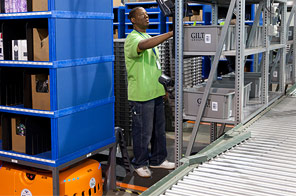In Warehouses, Kiva's Robots Do the Heavy Lifting
Jairus Dennis, a packer for the ritzy online retailer Gilt Groupe, works on a kind of warehouse dream team. Every few seconds, colleagues fetch him heavy shelves stacked with skinny jeans and red dresses. No one ever complains or slows down.

Dennis’s colleagues are orange and just 18 inches tall: they are robots, and they do much of the work in Gilt’s sprawling logistics center near Louisville, Kentucky. Sixty of the automated dollies crisscross the floor carrying shelves to humans, who pick, pack, and ship items without ever taking more than a couple of steps.
Dennis, a 21-year-old who has worked in the warehouse for a year and a half, likes the robotic help. “I prefer it. You don’t have to walk around eight hours a day,” he says.
The presence of the robots reflects a major shift for warehouses, where conveyer belts, forklifts, and a lot of manual labor have been the norm. Until recently, robots were too awkward and expensive to make much of a difference. But that is changing as Web retailers look for an edge in a business with low margins and sharp competition.
“As prices drop and become more accessible to more companies, you’ll see a rapid incline in growth” in warehouse robotics, predicts Marc Wulfraat, president of MWPVL International, a supply chain and logistics consulting company.
Earlier this year, Amazon gave its endorsement to warehouse automation by acquiring Kiva Systems, the manufacturer of the robotic systems used by Gilt. Amazon, which was already a customer of Kiva’s through its Diapers.com business, paid $775 million to acquire the company. In addition to Amazon, Kiva’s customers include Office Depot, Staples, Crate & Barrel, Toys “R” Us, and Saks Fifth Avenue.
Gilt started in 2007 as a flash-shopping site where customers have a limited time to buy discounted designer fashions. That recipe caught on quickly, turning Gilt into an e-commerce darling. From its Louisville facility, Gilt now ships more than 20,000 items on an average day.
Keeping up with the growth of Web sales has been a challenge. As part of a broader effort to make the company’s supply chain more cost-efficient, Gilt installed the robots two years ago. They cost more than $5 million, plus monthly maintenance fees.
In a typical warehouse, humans fill orders by hiking through rows of shelves, often carrying portable radio-frequency scanners to locate products. Computer systems and conveyer belts help speed things up, but only to a point. With the help of robots, workers at Gilt are able to process items three times faster, says Steve Eddy, Gilt’s director of distribution.
Videographer: Verne Kopytoff | Narrator: Antonio Regalado | Editor: Kyanna Sutton
After an order comes in to Gilt’s website, a robot automatically wheels into a grid of 1,600 shelves arranged in tight rows. The robot locates the right shelf, lifts it onto its back, and carries it to a picking station, where human workers take what is needed.
No one gets much rest. Workers pick between 200 and 250 items hourly. “If you see somebody at a Kiva station sitting around doing nothing, then we’re managing it wrong,” said Chris Halkyard, Gilt’s chief supply chain officer and the person who decided to buy the warehouse robots.
To avoid human error and speed the picking, a red laser overhead flashes on the item that workers need to grab. A robot then hauls the shelf back to the stacks, and another robot quickly pulls up to the picking station.
Kiva’s robots receive instructions wirelessly from a central computer that keeps them from running into each other. QR-code stickers on the floor help navigate. The system automatically detects when an item is a hot seller, and parks those shelves closer to the picking stations. From above, the scene looks a little like robot rush hour as dozens of shelves zoom around the warehouse floor.
It’s difficult to calculate how much money Gilt saves using robots, says Halkyard. But he says the system performs so well that he would install it all over again. “We’re getting our money’s worth,” he says.
Still, Halkyard points to several shortcomings that companies should consider before buying these robots. For example, using them on inventory that gathers dust isn’t cost-effective, and larger items also pose problems for the automated shelves.
At Gilt, robots handle only the most popular goods, which are concentrated in a 40,000-square-foot section of the warehouse. (The entire building is 300,000 square feet, almost the size of six football fields.) Yet the relatively small area where robots operate accounts for 65 percent of all items shipped from the warehouse, including Gilt’s signature flash-sale items, which generate a flood of orders.
The ultimate challenge is to build a robot that can do all the picking, packing, and shipping. But variations in the size and shape of merchandise, and its position on shelves, make this an extremely difficult task to automate. For now, at least, human workers will keep that job.
Keep Reading
Most Popular
Large language models can do jaw-dropping things. But nobody knows exactly why.
And that's a problem. Figuring it out is one of the biggest scientific puzzles of our time and a crucial step towards controlling more powerful future models.
The problem with plug-in hybrids? Their drivers.
Plug-in hybrids are often sold as a transition to EVs, but new data from Europe shows we’re still underestimating the emissions they produce.
Google DeepMind’s new generative model makes Super Mario–like games from scratch
Genie learns how to control games by watching hours and hours of video. It could help train next-gen robots too.
How scientists traced a mysterious covid case back to six toilets
When wastewater surveillance turns into a hunt for a single infected individual, the ethics get tricky.
Stay connected
Get the latest updates from
MIT Technology Review
Discover special offers, top stories, upcoming events, and more.